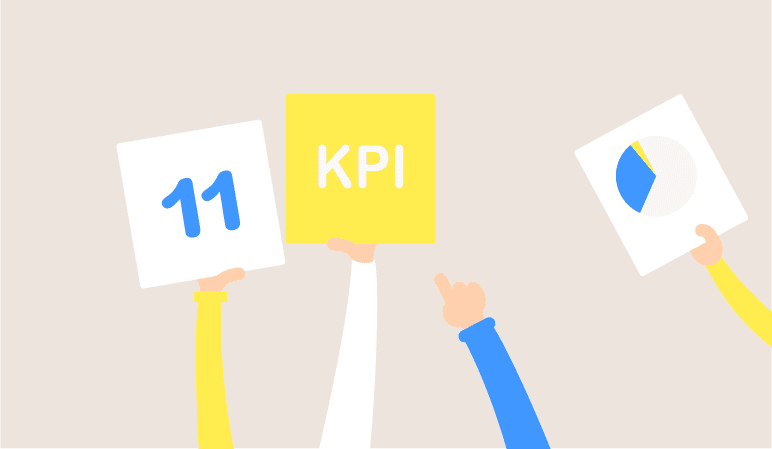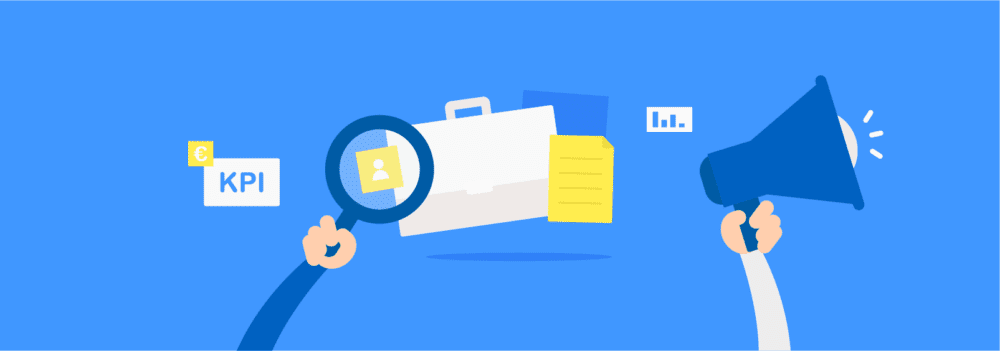11 crucial KPIs for HR professionals
Key performance indicators (KPIs) are important variables used to analyze an organization’s performance. Using clearly formulated KPIs, you can determine whether you’re still on course to achieving the objectives you’ve set. This methodology also applies to your HR policy. But what are the most important KPIs in HR? And how should you define and measure these in practice? These are...


Key performance indicators (KPIs) are important variables used to analyze an organization’s performance. Using clearly formulated KPIs, you can determine whether you’re still on course to achieving the objectives you’ve set.
This methodology also applies to your HR policy. But what are the most important KPIs in HR? And how should you define and measure these in practice? These are the questions we’ll be answering in this article.
What are HR KPIs?Copied
Before discussing which KPIs are essential for sound HR policy, it’s useful to define exactly what an HR KPI is.
Let’s take a closer look!
This article examines the KPIs that are crucial for an organization’s HR objectives. HR KPIs are indicators that you can use to demonstrate how your HR department is contributing to the rest of the organization.
What added value is your HR team providing with its activities? To what extent are you achieving the objectives laid down in your company’s HR strategy?
And are these assessed in relation to your organization’s KPIs as a whole?
Why are KPIs important in HR?
There are many reasons why KPIs are important for analyzing and monitoring your HR strategy. They act as a benchmark by which you can determine how you’re progressing toward achieving important company objectives. Are you on track or have you strayed from the path?
What’s more, KPIs also measure your workforce’s effectiveness and stability. Do you have all the required knowledge, skills, and competences in house or should you be taking action in terms of recruitment, selection, and retention?
Formulate SMART KPIs
A meaningful and useful KPI can best be formulated using the SMART method. This means that the KPI satisfies the following criteria:
- Specific – is the KPI’s objective clear and unambiguous?
- Measurable – can you determine whether the goal has been reached, using an objective form of measurement?
- Acceptable – are the KPI and its objectives acceptable to and supported by staff and management?
- Realistic – is the set objective achievable?
- Time-related – when do you need to achieve the objective by?
The most important KPIs for HR professionalsCopied
Now we know what KPIs are and what value they provide, it’s time to take a look at some of the most important KPIs for modern-day HR professionals. We’ve found eleven such KPIs:
- Return on investment (ROI)
- Productivity
- Retention
- Turnover
- Incidents
- Absenteeism
- Recruitment costs
- Satisfaction
- Skills & competences
- Time to fill
- Recruitment channel efficiency
We’ll discuss each of these HR KPIs below:

1. Return on investment (ROI)
An important KPI for HR managers is return on investment (ROI). A company’s financial ROI is easy to measure – simply divide the net profit by its costs.
However, a thorough ROI analysis also looks at specific investments such as those in personnel. Examples include training staff to elevate their knowledge and skill levels, which in turn boost your company’s competitiveness.
ROI in HR answers questions such as:
- What is the cost per hire? How much does the organization invest in recruitment, selection, and onboarding (advertising, referral bonuses, travel expenses, billable hours, etc.)?
- How effective are the training courses provided?
- What are the training costs per employee? Are these costs commensurate with the gains made in the form of more highly skilled staff, increased competitiveness, and a broader/better product/service range?
- Do the time and effort you put into recruiting new staff lead to good matches?
- Do investments into internal training programs result in staff promotions?
2. Productivity
You can measure productivity in one of several ways. For example, you could assess efficacy (are staff doing the right things?) or efficiency (are important tasks and processes being performed correctly?). What’s more, you can measure productivity by either effort or results.
Important productivity terms for HR include performance rating (how well employees perform their tasks) and employee productivity rate (how productive employees are).
It’s also advisable to examine the average time employees and departments take to achieve their goals or targets.
3. Retention
Employee retention is the cornerstone of an organization’s stability. It allows you to monitor how long on average employees remain in employment.
Retention is calculated by looking at the number of employees entering employment with your company compared to the number staying in the company across the same period.
If staff turnover is high, then it may be advisable to pay more attention to onboarding or take a closer look at remuneration (not just financial).
4. Turnover
High staff turnover is never a positive attribute! It lumbers you with additional costs every time you have to invest in recruiting and selecting new staff. What’s more, you have to constantly onboard and orient them within your organization. And worst of all, when someone leaves, they take valuable knowledge and experience with them.
If you notice that turnover is on the high side, check whether your staff have sufficient room for growth and promotion. To measure turnover, divide the number of staff leaving the company by the total number of employees over a given period.
5. Incidents
This KPI is possibly not as obvious as you might think, but nonetheless it’s still quite important. You can use the number of incidents to help reduce the risk of an accident or other undesirable situation arising. A pleasant, safe working environment helps boost employee satisfaction and loyalty levels.
6. Absenteeism
Absenteeism by definition has a major impact on your company’s results. High absenteeism levels mean work doesn’t get done for longer periods and is carried out less efficiently, which in turn can be detrimental to other related processes.
By calculating the average number of hours worked, you can determine the impact of absenteeism on your operating costs.

7. Recruitment costs
Recruitment and selection cost money. Period. Take, for example, the costs incurred for advertisements and recruitment campaigns. Naturally, you expect these investments to pay off.
This KPI helps you determine this as well as the following factors.
- Cost efficiency. What does it cost on average to recruit and select a new member of staff? How long does it take to recruit and select them? Add up these costs and divide the total by the number of new hires to determine your recruitment costs.
- Speed. The time it takes to fill a vacancy also affects your total costs. For example, certain activities may be lying still or carried out by fewer members of staff while key job vacancies remain unfilled. This HR KPI looks at how fast vacancies are being filled and what effect speed has on performance.
- Channel differentiation. Not every candidate uses the same channels to look for employment or new professional challenges. What’s more, there are many ways to find new employees. Differentiating these channels and determining which are useful is crucial to drafting a sound recruitment strategy. KPIs make this measurable, as you’ll not have to waste any more time, money, or effort on channels that provide little or no value to your organization.
8. Satisfaction
Employee satisfaction levels determine how loyal your staff are and have a direct impact your organization’s stability and overall success.
A useful tool for measuring this HR KPI is the eNPS – Employee Net Promoter Score. The eNPS reveals how likely it is that a given employee would recommend his or her employer to someone else.
It uses an 11-point scale (0–10) and the overall result is expressed as a percentage based on the scores given by those that would recommend your organization less those that wouldn’t. You can use eNPS to gain an initial insight into your employees’ motivation levels and how you could improve the working environment.
9. Skills & competences
It’s important that HR managers know what skills and competences exist or are missing within their organization, because the sum total of these is vital to its strength and flexibility.
Using AG5’s skills management software, you can accurately map the skills and competences present at an organizational, departmental, or individual level. What’s more, you also have immediate access to all details on the work floor, giving you a clear picture of employees’ progress throughout their career.
10. Time to fill
Time to fill is an HR KPI that measures how well your recruitment team and processes perform. It shows how long it takes to find a suitable candidate from the moment you announce the vacancy to the point you hire a new member of staff.
A short time to fill is obviously highly beneficial, as this means work can be resumed quickly and continuity can be safeguarded.
11. Recruitment channel efficiency
Chances are you’re using various channels to look for suitable candidates, for example recruitment & selection agencies, advertisements, employment agencies, and social media, such as LinkedIn and possibly even Facebook.
This HR KPI provides an insight into where you find the right people and which channels candidates are most likely to use.
Don’t skimp on your HR KPIs!Copied
Well-formulated KPIs make an HR manager’s job a lot easier. They provide valuable information and insights about the variables that affect the success of your HR strategy.
Measuring these KPIs is even easier and more effective when you use the right HR tools.
AG5’s software is a prime example – it gives you a clear and complete picture of all your staff’s knowledge, skills, and competences.
Curious about the benefits? Feel free to get in touch or schedule a live demo.
Use AG5 to identify skill gaps
Say goodbye to Excel matrices. Start using AG5’s plug and play skill matrix software.
ISO27001 certified
Free trial available
